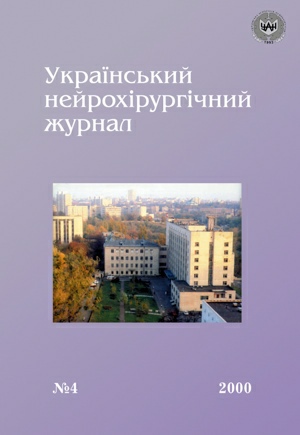An effectiveness using transpedicular fixation instrumentation for spine arthrodesis
Keywords:
spine stabilization methods, transpedicular systemAbstract
The objective of this research was to determine the efficacy and safety of an instrumentation device designed for transpedicular spinal fixation by evaluating fusion rates and clinical pain and function scores; to determine complication rates associated with the device; and to compare the obtained data with that previously published in the literature. Thirty-six consecutive patients were enrolled in this 3-year monitored investigation. The study population was derived from three diagnostic categories: tumour of spine, spondylolisthesis and degenerative disc disease, vertebral fracture. The data source consisted of radiographs, clinical examination. Patients were evaluated preoperatively, intraoperatively, and postoperatively at 3, 6 months. These data compare favourably to existing reports of spinal arthrodesis effected with other types of instrumentation and without device implantation. In a 3-year trial, the transpedicular fixation instrumentation produced successful spinal fusion in the majority of our patients, with acceptable complication rates.
References
Зозуля Ю.А., Полищук Н.Е., Слынько Е.И., Муравский А.В. Транспедикулярная система стабилизации позвоночника // Бюллетень УАН. — 1998. — №.6. — С.142—143.
Корж А.А., Талышинский Р.Р., Хвисюк Н.И. Оперативные доступы к грудным и поясничным позвонкам (Анатомо-хирургическое обоснование). — М.: Медицина, 1968. — 203 с.
Хвисюк Н.И., Корж Н.А., Маковоз Е.М. Нестабильность позвоночника // Ортопед. травматол.— 1984. — №3. — С.1—7.
Хвисюк Н.И., Продан А.И., Середа Д.М., Лыгун Л.Н. Фиксатор позвоночника // Изобретения. —1997. — №2. — С.9.
Colak A., Kutlay M., Demircan N. et al. MR imaging for early complications of transpedicular screw fixation // Eur. Spine J. — 1999. — N.8. — P.151—155.
Eger W., Kluger P., Claes L., Wilke H.J. Characteristics of an extended internal fixation system for polysegmental transpedicular reduction and stabilization of the thoracic, lumbar, and lumbosacral spine // Eur. Spine J. — 1999. —N.8. — P.61—69.
Johnsson R., Axelsson P., Gunnarsson G., Stromqvist B. Stability of lumbar fusion with transpedicular fixation determined by roentgen stereophotogrammetric analysis // Spine. — 1999. — N.24. — P.687—690.
Kanayama M., Cunningham B.W., Sefter J.C. et al. Does spinal instrumentation influence the healing process of posterolateral spinal fusion? An in vivo animal model // Spine. — 1999. — N.24. — P.1058—1065.
Katonis P.G., Kontakis G.M., Loupasis G.A. et al. Treatment of unstable thoracolumbar and lumbar spine injuries using Cotrel-Dubousset instrumentation // Spine. — 1999. — N.24. — P.2352—2357.
Kim N.H., Lee J.W. Anterior interbody fusion versus posterolateral fusion with transpedicular fixation for isthmic spondylolisthesis in adults. A comparison of clinical results // Spine. — 1999. — N.24. — P.812—816.
Margulies J.Y., Caruso S.A., Chattar-Cora D. et al. Substitution of transpedicular screws by hook claws in a vertebrectomy model // J. Spinal Disord. — 1998. — N.11. — P.36—40.
Muller U., Berlemann U., Sledge J., Schwarzenbach O. Treatment of thoracolumbar burst fractures without neurologic deficit by indirect reduction and posterior instrumentation: bisegmental stabilization with monosegmental fusion // Eur. Spine J. — 1999. — N.8. — P.284—289.
Stambough J.L. Lumbosacral instrumented fusion: analysis of 124 consecutive cases // J. Spinal Disord. — 1999. — N.12. — P.1—9.
Tohmeh A.G., Mathis J.M., Fenton D.C. et al. Biomechanical efficacy of unipedicular versus bipedicular vertebroplasty for the management of osteoporotic compression fractures // Spine. — 1999. — N.24. — P.1772—1776.
Downloads
How to Cite
Issue
Section
License
Copyright (c) 2000 Mykola Polishchuk, Eugene Slynko, Andriy Muravskiy

This work is licensed under a Creative Commons Attribution 4.0 International License.
Ukrainian Neurosurgical Journal abides by the CREATIVE COMMONS copyright rights and permissions for open access journals.
Authors, who are published in this Journal, agree to the following conditions:
1. The authors reserve the right to authorship of the work and pass the first publication right of this work to the Journal under the terms of Creative Commons Attribution License, which allows others to freely distribute the published research with the obligatory reference to the authors of the original work and the first publication of the work in this Journal.
2. The authors have the right to conclude separate supplement agreements that relate to non-exclusive work distribution in the form of which it has been published by the Journal (for example, to upload the work to the online storage of the Journal or publish it as part of a monograph), provided that the reference to the first publication of the work in this Journal is included.









